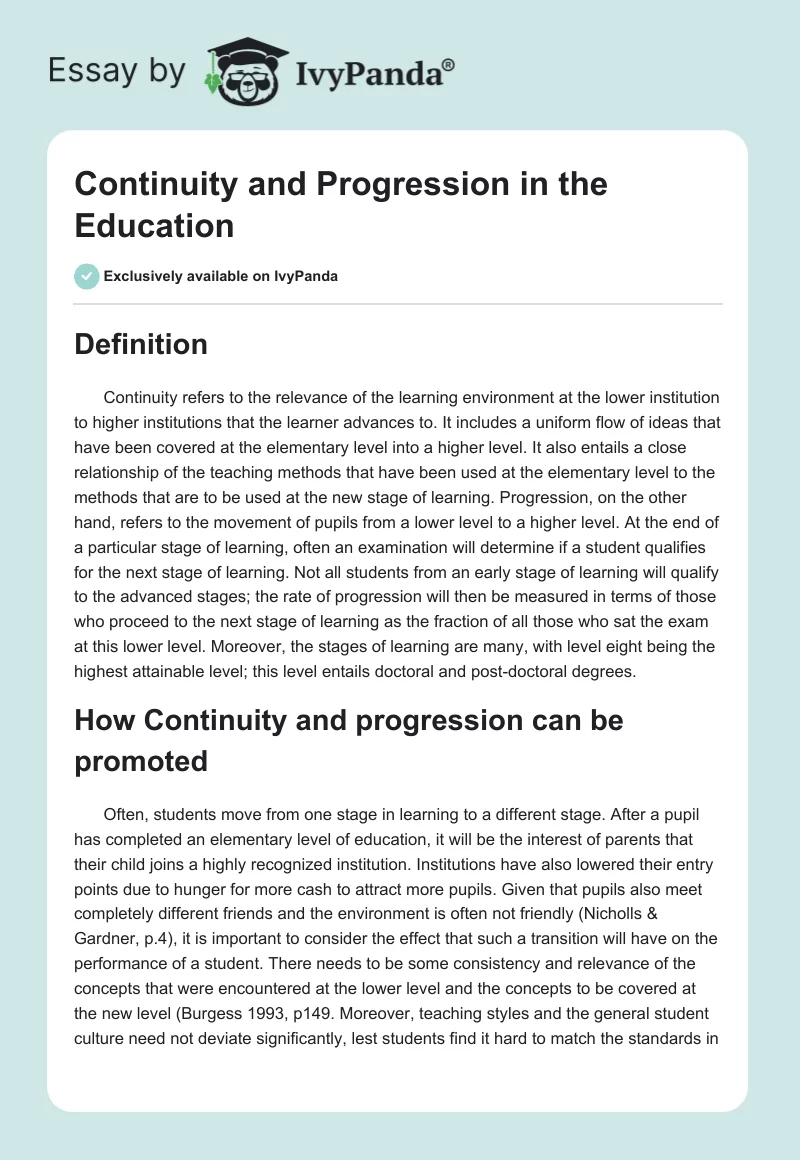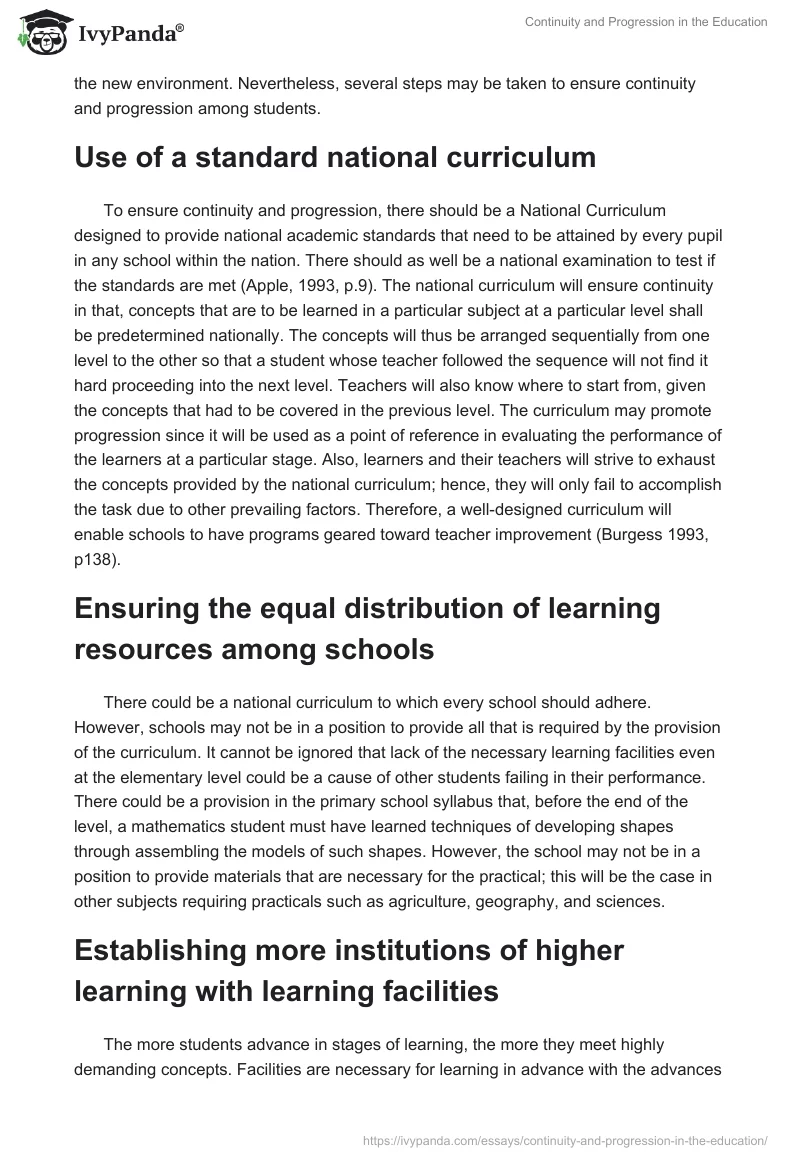- Definition
- How Continuity and Progression Can Be Promoted
- Use of a Standard National Curriculum
- Ensuring the Equal Distribution of Learning Resources Among Schools
- Establishing More Institutions of Higher Learning with Learning Facilities
- Conducting Exchange Programs Among Students and Teachers From Different Schools
- Reference List
Definition
Continuity refers to the relevance of the learning environment at the lower institution to higher institutions that the learner advances to. It includes a uniform flow of ideas that have been covered at the elementary level into a higher level. It also entails a close relationship of the teaching methods that have been used at the elementary level to the methods that are to be used at the new stage of learning. Progression, on the other hand, refers to the movement of pupils from a lower level to a higher level.
At the end of a particular stage of learning, often an examination will determine if a student qualifies for the next stage of learning. Not all students from an early stage of learning will qualify to the advanced stages; the rate of progression will then be measured in terms of those who proceed to the next stage of learning as the fraction of all those who sat the exam at this lower level. Moreover, the stages of learning are many, with level eight being the highest attainable level; this level entails doctoral and post-doctoral degrees.
How Continuity and Progression Can Be Promoted
Often, students move from one stage of learning to a different stage. After a pupil has completed an elementary level of education, it will be the interest of parents that their child join a highly recognized institution. Institutions have also lowered their entry points due to hunger for more cash to attract more pupils.
Given that pupils also meet completely different friends and the environment is often not friendly (Nicholls & Gardner, p.4), it is important to consider the effect that such a transition will have on the performance of a student. There needs to be some consistency and relevance of the concepts that were encountered at the lower level and the concepts to be covered at the new level (Burgess 1993, p149. Moreover, teaching styles and the general student culture need not deviate significantly, lest students find it hard to match the standards in the new environment. Nevertheless, several steps may be taken to ensure continuity and progression among students.
Use of a Standard National Curriculum
To ensure continuity and progression, there should be a National Curriculum designed to provide national academic standards that need to be attained by every pupil in any school within the nation. There should as well be a national examination to test if the standards are met (Apple, 1993, p.9). The national curriculum will ensure continuity in that, concepts that are to be learned in a particular subject at a particular level shall be predetermined nationally. The concepts will thus be arranged sequentially from one level to the other so that a student whose teacher followed the sequence will not find it hard proceeding into the next level. Teachers will also know where to start from, given the concepts that had to be covered in the previous level.
The curriculum may promote progression since it will be used as a point of reference in evaluating the performance of the learners at a particular stage. Also, learners and their teachers will strive to exhaust the concepts provided by the national curriculum; hence, they will only fail to accomplish the task due to other prevailing factors. Therefore, a well-designed curriculum will enable schools to have programs geared toward teacher improvement (Burgess 1993, p138).
Ensuring the Equal Distribution of Learning Resources Among Schools
There could be a national curriculum to which every school should adhere. However, schools may not be in a position to provide all that is required by the provision of the curriculum. It cannot be ignored that lack of the necessary learning facilities even at the elementary level could be a cause of other students failing in their performance. There could be a provision in the primary school syllabus that, before the end of the level, a mathematics student must have learned techniques of developing shapes through assembling the models of such shapes. However, the school may not be in a position to provide materials that are necessary for the practical; this will be the case in other subjects requiring practicals such as agriculture, geography, and sciences.
Establishing More Institutions of Higher Learning with Learning Facilities
The more students advance in stages of learning, the more they meet highly demanding concepts. Facilities are necessary for learning in advance with the advances in learning level. As a result, there are fewer institutions of higher learning than middle-level institutions. This makes entry into these institutions very competitive, increasing the minimum qualification for admission. Very capable students are locked out of programs that they could easily pursue due to the limited chances available. The establishment of such institutions and the commitment of the government and other stakeholders to provide necessary learning facilities could help to lower the number of students that are barred from proceeding to higher levels.
Conducting Exchange Programs Among Students and Teachers From Different Schools
Following a standard curriculum may still not be effective if the students and their teachers are restricted to their school or region in which their school falls. There should be academic exchange programs between schools from different parts of the country so that the students and teachers can share and exchange ideas related to the various subject areas. Besides, there should be programs that bring together teachers of a particular subject from across the nation. Teachers could occasionally be exchanged between schools (Burgess 1993, p147). Such seminars, if well organized, will help teachers to have a common understanding of concepts in the subject areas.
Mathematics and science congress among different schools can help to bring together pupils and teachers from different parts of the country. Similarly, there could be interschool exams that are provided by a union of different schoolteachers with an official release of results at one common institution. This will provide a good platform for teachers to address the emerging issues concerning performance that shall have been obtained. The students on the other hand will share ideas with their counterparts from other schools and if this is practiced throughout the country, then there will be an improvement in the general performance of the whole country. Progression into the next stage will thus be improved.
Reference List
Apple, M., 1993. The Politics of Official Knowledge: Does A National Curriculum Make Sense?Teachers College Record, Vol.95, No.2. Web.
Burgess, R., 1993. Implementing in-service education and training. London: Routledge. Web.
Nicholls, G. and Gardner, J., 1999. Pupils in transition: moving between key stages. London: Routledge. Web.


